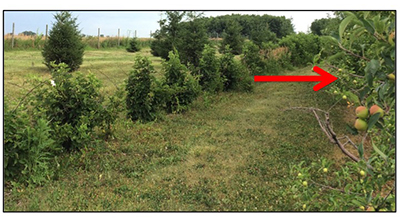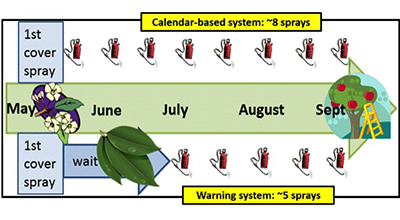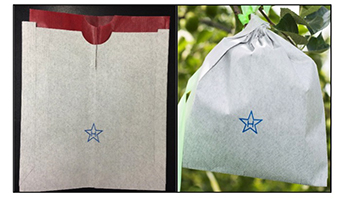CAST OF CHARACTERS
Umar Mukhlis: A small-scale apple grower in Ames, Iowa
Dr. Hannah Wilson: Extension plant pathologist at Iowa State University
CLASSROOM MANAGMENT
Click
here to view the suggested classroom managment for this case including an additional overview & summary, case objectives, and suggestions for how to use the case.
BACKGROUND INFORMATION
Click
here to view the background infromation for this case study.
THE CASE
A Cosmetic Disease
Since customers are on his farm almost daily during the peak of his sales season in autumn, Umar has developed friendships with many of them, and is focused on keeping them happy (Figure 1). In addition to keeping his orchard and sales areas clean and attractive, he goes the extra mile to produce beautiful, perfect-looking apples. Customers responded well, and his business was profitable and growing steadily.

Figure 1.
Abruptly, a dark cloud appeared on Umar’s horizon. A recent, highly publicized scientific study showed that fungicide residues - the fungicide remaining on the surface of apples after they are sprayed - could be harmful to consumers’ health. Reading this news, some of Umar’s customers became alarmed. Several told him they were worried about their children’s health if they ate Umar’s apples or apple products. Umar tried to reassure them that the fungicide residues, if any, could be easily washed off the apples, that he washed and brushed all apples before selling them, and that all the apple peels (where the fungicide residue would be) were removed when his pies were made. But his customers - particularly those who liked to pick their own fruit in the orchard - have remained worried. Farm visits have dropped noticeably, and sales of all his apple products have slowed down. As a result, Umar’s profit margin has also dropped, to the point where he is beginning to fret about his ability to make payments on the bank loan that enabled him to buy the orchard and his house, which is also on the property. How will he support his young family if the orchard business fails?
To stop the free-fall in sales, Umar needs to make changes. But what should he change? If he cuts back on fungicide spraying against SBFS, his apples might have more dark blotches on the peel, so they would look less attractive to customers.
Can he convince his customers to buy superficially SBFS-smudged but otherwise high-quality apples in exchange for a lower risk of possibly hazardous fungicide spray residues? Umar is proud of his reputation for producing blemish-free apples, and is concerned that his customers will reject fruit with SBFS blotches. How should he head off this crisis?
SOOTY BLOTCH AND FLYSPECK
Umar knew what SBFS signs looked like (Figure 2), but he needed to figure out how to win back his customers and recover his sales volume.

Figure 2.
Searching for more information, Umar contacted Dr. Hannah Wilson, an Extension plant pathologist at Iowa State University. Dr. Wilson told Umar that SBFS is caused by many different species of fungi that survive the cold Iowa winter on the twigs, canes, and fruit of many types of plants, such as blackberry (Rubus spp.) (Figure 3), that grow naturally near the edges of the orchard. Because they live outside the orchard borders, these plants never get sprayed with fungicides. In the late spring, summer, and early fall, as apples are maturing in the orchard, microscopic spores spread - on air currents and in raindrops - from the orchard borders into the orchard and land on the fruit.

Figure 3.
After spores land on the apples, periods of rainy weather or dew stimulate them to germinate into a tangled mass of fungal strands called a mycelium. Several weeks or months later, these tangles grow and darken enough to be visible on the fruit surface, sometimes peppered with tiny black dots (called sclerotium-like bodies) scattered in the mycelium (Figure 4a). Different species of SBFS fungi grow into different types of visible mycelium on the surface of the fruit (Figure 5). The SBFS fungi burrow into the outer wax layer of the apple peel, but never penetrate below the epidermis into the living cells of the fruit (Figure 4b). They survive by absorbing nutrients that leach out from the fruit flesh onto the peel and by breaking down waxes, cutin and other substances that compose the non-living outer layer of the fruit surface.

Figure 4.

Figure 5.
As surface dwellers, SBFS fungi are very sensitive to weather conditions. Water (from rainfall or dew) helps them to grow, but they stop growing during dry weather. As a result, growing seasons with high rainfall and long-lasting dew periods pose a greater risk of SBFS outbreaks than relatively dry seasons. Umar knows all of this. But how can he manage to keep control of SBFS while meeting his customers’ requests to cut back on fungicide spraying?
Umar called Dr. Wilson to get some suggestions. Hannah was familiar with recent SBFS research in the Midwest that tested a management tool called a disease-warning system. The idea behind the warning system is simple: keep track of the weather, and apply a fungicide spray only when the weather-related risk of an outbreak is high. Dr. Wilson explained that once the apples began to form on the tree (fruit set), around the time when first summer fungicide spray (first-cover spray, illustrated in Figure 6) is applied, the SBFS warning system recommended applying the next fungicide spray only after a total of 385 hours of relative humidity (RH) above 90% had accumulated since the date of the first-cover spray. The 90% RH threshold was chosen because the apples were usually wet above that level of moisture, creating favorable conditions for SBFS fungi to infect and grow. After the threshold is reached and a fungicide spray is applied, the warning system recommends returning to a regular 14-day-interval spray schedule for the remainder of the growing season. After years of testing the warning system in Iowa orchards, the researchers found that it saved three fungicide sprays per year on average - a 38% savings compared to the traditional spray-by-the-calendar method, while still keeping the apples free of SBFS blotches (Figure 6).

Figure 6.
Trying out this warning system in his own orchard sounded promising to Umar. Compared to the current calendar-based system that he has been practicing in his orchard, saving three fungicide sprays per year could help to convince his customers that he was taking some meaningful steps to cut back on fungicide use. But Hannah cautioned that using the warning system also meant taking some time to monitor RH in his orchard. The monitoring could be done automatically by fairly inexpensive (about $500) RH sensors and data loggers that measures and record RH every hour. However, Umar would need to check on the weather station at least once a week, and download the recorded data to a laptop computer or other mobile device in order to determine when he should spray. On the other hand, applying fewer sprays would save Umar money, since it costs him about $50 per acre per spray. Another plus was the prospect of saving time during his busy summer; instead of spending many hours riding the slow-moving (3 miles per hour) sprayer up and down the rows of apple trees, he could spend the time doing other tasks on the farm. But Umar also had some doubts. So far, the warning system had been tried out only on university farms in Iowa; he would be the first commercial apple grower to use the system. What if something went wrong? Would he then have an entire orchard of SBFS-blemished apples?
Umar’s daughter suggested a way to eliminate summer fungicide sprays: persuade his customers to buy SBFS-smudged apples. If the customers understood that SBFS spots posed no health hazard, that they didn’t affect the eating quality of the apples except for appearance, and that more SBFS spots meant less risk of fungicide spray residue on the apples, would they be willing to buy his apples again? Could he convince them the smudgy apples were actually safer to eat and more environmentally friendly than perfect-looking ones (Figure 7)?

Figure 7.
Umar’s wife had yet another idea: stop selling fresh apples entirely, and sell only pies and apple cider. This strategy would eliminate the need for all of the summer fungicide sprays, and no SBFS smudges would be visible in the processed apple products. Umar hesitated to try this, however, because he knew that the labor and machinery required to process apples narrowed his profit margin by about 50% compared to fresh apples. Furthermore, what would he say to his pick-your-own and local farmers market customers? Should he change his orchard business plan to selling only apple cider and pies?
From experience, Umar knew that the earliest-harvested apple varieties (picked in late July and early August) almost never have problems with SBFS. In a recent meeting of growers, Hannah Wilson explained that early-maturing apple varieties seem to “escape” SBFS problems because they are harvested before these fungi have enough time to produce visible colonies. But even though some early apple varieties can be good for pies and cider, his customers strongly prefer the later-maturing varieties as fresh fruit. On one hand, switching to plant only early-maturing varieties in his orchard would help Umar to stop worrying about SBFS and also could drastically reduce the need for fungicide spraying. But on the other hand, he suspected that he would lose his pick-your-own customers, and much of his profit as well. Should Umar consider this idea? He recalled that Dr. Wilson mentioned that the wild plants bordering the orchard could be harboring SBFS fungi. Umar was wondering if there is anything he could do to the 4 acres of woodlots and blackberries surrounding his orchards (Figure 8) in order to reduce the risk of SBFS outbreaks. Umar contacted Dr. Wilson for some answers.

Figure 8.
She mentioned that the shrubs and woodlots surrounding the orchard could be managed by removing the plants from the orchard border or spraying fungicides on the plants surrounding the orchard border. This approach could potentially reduce the source of SBFS spores. However, the effectiveness of this strategy had never been tested.
“There are other SBFS management strategies that can limit or even eliminate fungicide spraying when the fruit are developing,” she added. These management options include:
-
Bagging fruit
This is an approach that is not common in the U.S. but is widespread in China and Japan. By using specialized double-layer, air-permeable bags, sometimes called Japanese fruit bags, the apple fruit is covered for almost its entire development period (Figure 9). This approach is nearly 100% effective in keeping SBFS fungi away from the fruit. However, the installation of the bags must be done manually, and that means considerable extra labor and cost. In addition, the bag protects only the fruit; the leaves and stems are still exposed to other diseases and pests.

Figure 9.
-
Summer pruning
Decreasing the RH in the orchard would minimize the potential for SBFS outbreaks. One way to help the fruit dry off quickly after rain or dew periods is by pruning (strategically removing certain branches in winter or summer). Pruning reduces the density of tree canopy and thereby improves air circulation and helps the fruit to dry off quickly after rain or dew, so periods favoring growth of SBFS fungi will be shorter. In addition, opening up the tree canopy by pruning provides better coverage by fungicide sprays and better light penetration to insure high-quality fruit. Umar already prunes his trees every winter, but should he also prune during the summer? His major concern is where he would find the time to do summer pruning during the busy fruit production season.
-
Postharvest eradication
Currently, Umar uses water jets and nylon brushes to clean the surface of his direct-market apples before he sells them. But if he were to add a “dip tank” to his fruit cleaning line, he could remove most of the SBFS colonies from his apples. A 7-minute soak in a solution of chlorine bleach or fruit soap, followed by brushing on his grading line, could really improve the look of his apples. On the other hand, Dr. Wilson mentioned that research showed that some SBFS fungi are more difficult to remove than others, and some apple varieties are harder to clean off than others. Furthermore, going to a dip-and-brush cleaning method will require Umar to invest thousands of dollars in new equipment.
Umar was glad to know that there are other available strategies to manage SBFS. However, he had some concerns:
-
The bagging and pruning are both labor-intensive. Since he doesn’t have the time for summer pruning or bagging, should he hire more help? Can he even find reliable help for these difficult jobs?
-
Postharvest eradication using the dip-and-brush technique sounds promising. But with concerns about incomplete wash-off of the SBFS colonies, should he spend the money for new equipment, as well as expand his packing shed to house the cleaning line?
-
Since Dr. Wilson said that woodlots next to orchards harbor the SBFS fungi, should he spray fungicides on those areas? Alternatively, should he clear off the woodlands surrounding his orchard to prevent them from being a reservoir for SBFS? The money and time to accomplish this would be substantial; is it worth it?
What should he do? Help Umar figure out the best course of action to manage SBFS in his orchard.
QUESTIONS
- What are the signs of sooty blotch and flyspeck on apple fruit?
- Where do SBFS fungi survive the winter?
- What is a disease-warning system? Explain briefly the principle behind the SBFS warning system.
- Putting yourself in Umar’s situation, what management strategies you would choose? Do you think it would be more effective for Umar to rely heavily on one strategy, or should he integrates multiple strategies? Develop a disease management plan and explain your choices.
- What strategies could Umar use to influence his customers to purchase SBFS-blotched apples?
- What additional strategies you can think of that could help Umar to overcome this crisis?
ADDITIONAL QUESTIONS
- The proposed SBFS warning system was designed to save fungicide sprays during the middle portion of the growing system. However, once the warning system indicates that conditions are favorable for SBFS (threshold is reached), the fungicide spray program returns to a calendar-based schedule i.e. sprays every 10 to 14 days until harvest. Figure 6 shows this transition. Assuming that late-season sprays contribute the most to fungicide residues at harvest, is the warning system really reducing the risk of residues on harvested apples? If not, does that mean that the warning system will be not useful in Umar’s situation?
- SBFS damage to apples is only skin deep and does not harm the eating quality of the fruit. In your opinion, should apple growers apply fungicides to control a “cosmetic” disease such as SBFS?
